Air quality reaches ‘unhealthy’ levels in Kona
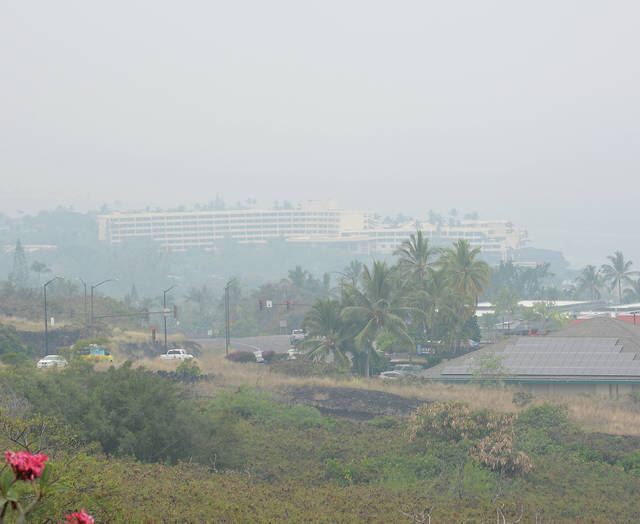
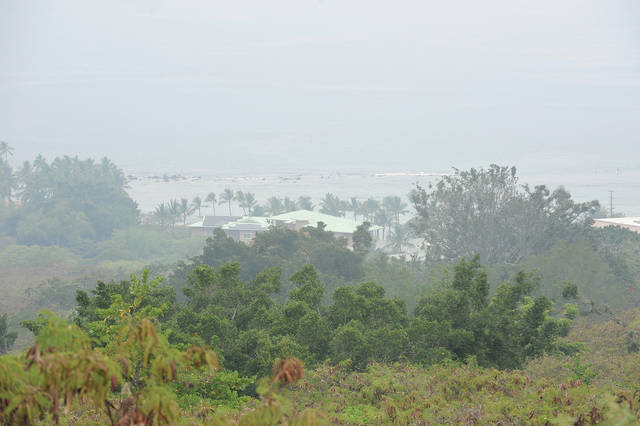
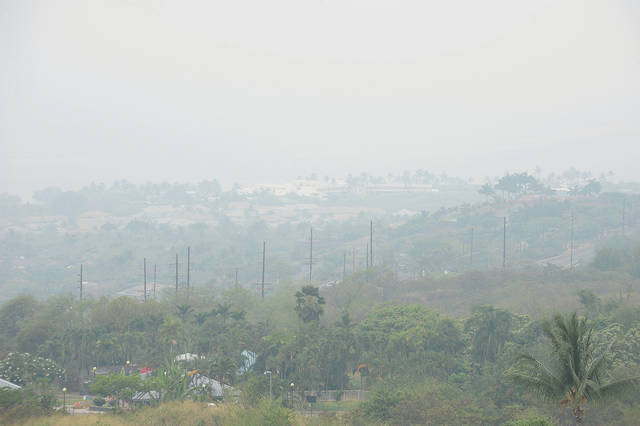
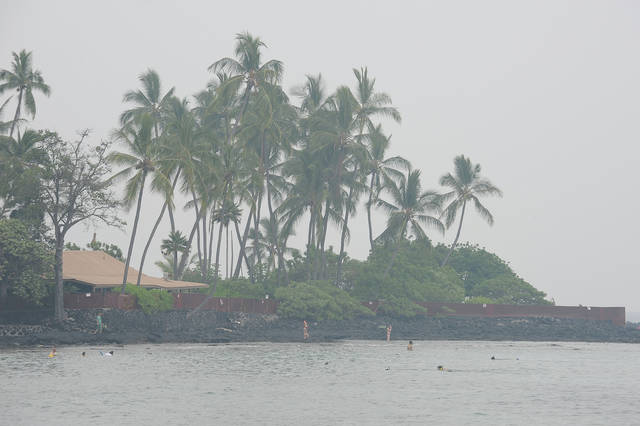
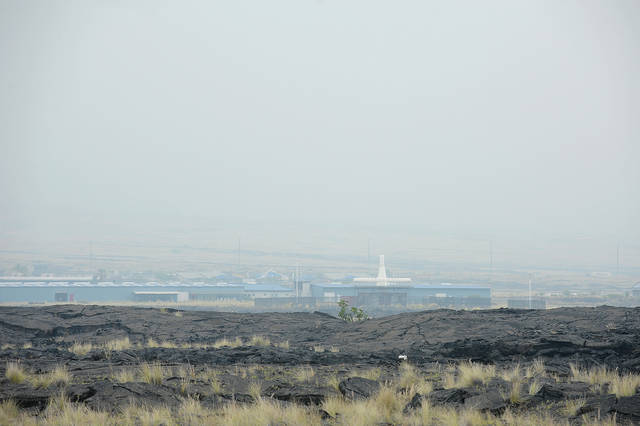
KAILUA-KONA — Hualalai was shrouded in vog as air quality reached “unhealthy” levels for some West Hawaii residents Tuesday.
KAILUA-KONA — Hualalai was shrouded in vog as air quality reached “unhealthy” levels for some West Hawaii residents Tuesday.
According to the state Department of Health, Kona was a “red” air day throughout the day. Since the installation of the air quality monitor in Kona in 2009, health officials say this was the first time they’ve seen West Hawaii reach these unhealthy levels.
“Unhealthy” is defined as everyone may begin to experience health effects and members of sensitive groups may experience more serious health effects.
“I’ve always known Kona to be ‘yellow.’ When the eruptions started, it went ‘orange,’” said Lisa Young, environmental health specialist with the Department of Health’s Clean Air Branch.
Vog began to get heavy after eruptions began in Puna in Leilani Estates on May 3. Numerous fissures have cracked open spewing lava. Many homes and structures have been destroyed.
While conditions have become hazardous in areas of Puna, the Ka‘u District has also been impacted by ashfall and West Hawaii continues to be bombarded with walls of vog.
Lacey Holland, post-doctoral fellow at University of Hawaii at Manoa’s Department of Atmospheric Sciences, said 2,500 tons of emissions were released into the atmosphere daily before this month’s volcanic activity.
Since May 3, Holland said 35,000 to 40,000 tons have been released. Concentrations drop down quickly away from its source.
“But here we’ve got like 15-20 times the amount of normal, so even though the concentrations do drop off really quickly when you’re away from the main area, there’s just a sheer number of vog-related molecules in the air — still causes the air quality to be much worse,” Holland said.
Concentration fluctuation has to do with weather patterns.
“Small shift in wind direction or speed can cause very different outcomes whenever it comes to the concentrations of sulfur dioxide or sulfate aerosols that you see in the air,” Holland said.
There’s a chance of vog-related air making its way to Oahu.
“Right now, with the wind (direction) … it just is blowing the emissions from the lower East Rift Zone almost directly to Kona,” Holland said.
There are two types of particulate matter measured: PM2.5 and PM10, which relate to the size of the particles. Young said PM2.5 is haze or smoke, while PM10 are bigger particles such as ash or dust.
“There’s so much more emissions coming now than there has been before, now everyone can see when it accumulates,” Young said.
A state representative said more needs to be done to inform the public about these “unhealthy” air days.
Nicole Lowen, D-North Kona, said conditions this past week have been severe and there are a lot of people feeling the effects who aren’t usually bothered by the vog.
“We deserve information from the county and the state Department of Health and to have our questions answered,” Lowen said.
The representative added that when air quality is in the “unhealthy” range, the public should be alerted.
“We don’t need to panic, but when you’re driving on the highway and you can’t see the ocean or the mountain, it’s pretty hard to keep pretending that the vog isn’t an issue,” Lowen said.
Young said the department is looking at sites to set up more particle sensors in Kona next week as well as trying to figure out how they can alert the community when these poor air quality days occur.
West Hawaii Today reached out to the Hawaii County Civil Defense Agency about why no alert was issued for the red air day in Kona. As of press time, no calls were returned.
While vog has hit an all-time level of discomfort these past few weeks, West Hawaii’s outdoor community continues to plan for its summer events.
Coming up on Saturday is the Ironman 70.3 Hawaii qualifier race in South Kohala. Greta Friesen, member of the board of directors of Hawaii Cycling Club, is competing. Since the lava flows started, she said she’s been playing it by ear as far as when she gets out to train.
“I’ve been down to every other day,” Friesen said of how often she trains.
While training, Friesen said she will get a sore throat and when she pushes, her lungs burn.
“So much of this is because it’s a lifestyle,” Friesen said of triathlons and training. “It’s just something you do everyday. To cut back on these things because of the weather, it’s like putting your life on hold. For so much of these people, it’s more than just training for a race.”
She added that she wouldn’t drop out because she’s stubborn.
Those who paddle at Kailua Pier are also watching the air quality but continue to train and plan for summer races.
Mike Atwood, athletic director Kai ‘Opua Canoe Club, said coaches addressed the air quality about three weeks ago. If they were to see signs of discomfort from their paddlers, they were to take appropriate action.
“Some have shown relatively minor reaction, but it hasn’t discouraged them from their normal workouts,” Atwood said.
The King Kamehameha Day Regatta is coming up on June 9. Atwood said there have been concerns from people not from the island about Lili‘uokalani race, the world’s largest long distance outrigger canoe race, which takes place Aug. 31-Sept. 4.
“We just tell them we’re monitoring it and working closely with the Department of Health and Civil Defense,” Atwood said.
Atwood said the media exposure has had a negative impact on the island, adding these conditions have been around since the first Hawaii settlers came to live here.
“Some of us are going to feel discomfort,” he said. “But for the most part the human body is a resilient thing. The majority of us, whether we’re athletes or not, can go about our lifestyles.”



What majority is he talking about? The majority I know certainly is not going about our usual lifestyles. Everyone is complaining about their lives being impacted by this poisoned air.
The VOG varies within the Kona area. Does anyone know where the readings are taken?
State officials voice concerns over the impact on decreased tourism. Free masks are offered to those living close to the volcano. But we can barely see across the street, tongue and throat burns while resting, see ash falling from the sky, white powder all over car, and we have to buy our masks online and wait. It is NOT our fault that tourism is dropping. We know the lava only covers a small % of BI. But the vog accumulates west side of island. And we get crickets while we choke.
your govt has never cared about people,for instants,no tretrooms or comfort stations from volcanos to kealakekua, boat launches are a joke when you can find parking…the roads are a joke if not dangerous,southpoint temporary luas,no thanks to nasty,oh and dont forget those increases in taxes for a rail line in oahu,I could go on but I,m bumming myself out, Aloha
The readings from multiple air quality sensors located in West Hawaii can be seen at “purpleair dot com”. Excellent resource, independent of the State efforts.
It is crazy and bizarre that all these ‘athletes’ are coming here for the Honu 1/2 Tri race . They were told that ” Nothing wrong with the air quality! Come on over ! Everything’s is fine ” Pure BS . The organizers are worried about losing $$$. To train or to race in this level of vog is insane , no matter whether the athlete is willing (stupid enough) or not . Call off this race .
Not for publication! A note to the WHT Comments Editor:
PLEASE publish my comment. You have rejected/not published two previous comments of
similar content. If you have decided not to publish it (and to withhold valuable information from
the general public), please give me reasons for your rejection. Please send your reply to
coro@hawaii.rr.com